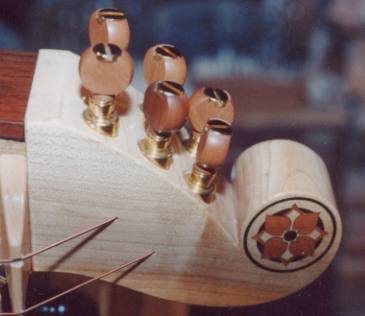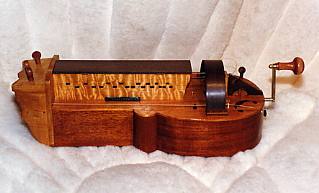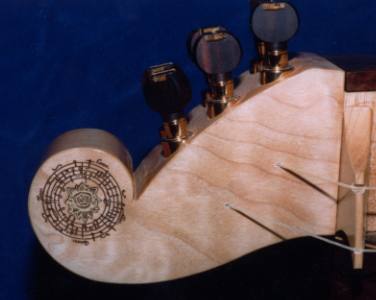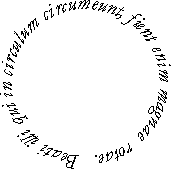
Tuning mechanism options
One of the choices facing a hurdy-gurdy customer is the question of whether to order traditional tapered tuning pegs or modern machine tuners. On most instruments the machine tuners are standard. There are actually three choices and some variations.
Machine tuners are mechanical tuning machines used in place of tuning pegs. We use high quality banjo tuners. These machines have 5:1 gearing, so tuning is easier when with friction pegs. The shaft is also smaller diameter, also making tuning easier. Machine tuners can be tuned by hand, without a tourne á gauche.

Volksgurdy with gold machines and mountain mahogany grips

Minstrel with gold machines
Traditional tuning pegs are held in position with a 1:30 taper, just like that of a violin peg. The pegs on our instruments are all handmade in our shop to exacting specifications. A violin peg shaft is too thin to withstand the sideways tension of the hurdy-gurdy string, and the head of the violin peg is an uncomfortable shape to use with a tourne á gauche, the traditional wrench used by hurdy-gurdy players to obtain fine adjustment. A tapered peg can be made from a variety of exotic hardwoods. Our preference is to use African blackwood or mountain mahogany, but other woods can be used if desired. The slight tapers on the sides of the head of the pegs are custom fitted to the inside of the tourne á gauche. In this way the tourne á gauche can be placed on top of a peg and left there during tuning.

Minstrel with traditional tuning pegs
Oversized heads for tuning pegs were introduced on the Minstrel as part of the Marcello Bono Signature Model. Marcello prefers the look and feel of friction pegs, and requested that we make the African blackwood pegs of his instrument with extra-large heads so that he could tune them without the aid of a tourne á gauche. We still provide a tourne á gauche for fine tuning, but find that the pronounced heads on these pegs are relatively easy to tune by hand and provide a "regal" look to the instrument.

Bono Signature Model with oversized heads on the friction pegs
If machine tuners are so much easier, why are tapered tuning pegs still used? There are several reasons. Some people prefer the traditional look, but more on that in a moment. Some instrument designs don't lend themselves to machine tuners. Some playing situations, such as Society for Creative Anachronism events and Renaissance Faires, would be inappropriate for gold or chrome plated machine tuners.
Both tuning machines and tapered pegs have potential disadvantages. In the mid 1990's, we observed that a few Schaller tuning machines were suffering from a joint failure. Since that time we have seen this problem less often, though occasionally a machine will simply fail from an internal part breaking. If a tuning machine breaks, it is relatively easy to replace, though a special tool is needed.
Tapered pegs can develop "flat spots" which make it difficult to tune easily, though this problem can be alleviated. Some people tend to forget that their tourne á gauche is swinging from the instrument's peghead when they stand up, resulting in dented furniture and spilled drinks. If a tapered peg breaks, a custom replacement needs to be made.
Tuning machine grips - We typically use gold-plated machine tuners, though the Orca has chrome-plated (silver-colored) machines. These machines are supplied with a pearlized plastic grip, which can look out of place on some instruments. The plastic grip can be replaced with a hardwood grip at an additional cost. Some of our favorite woods for these grips are African blackwood, cocobolo, and mountain mahogony. Other woods are available on request and at an additional cost. Wood grips for the tuning machines can be added by the player at any time.

Gold machines with African blackwood grips

Minstrel with African blackwood grips
Hidden tuning machines - Another option available is a set of hidden machine tuners. These are machines mounted inside the peghead, with grips which look just like the heads of friction pegs. This design was pioneered by Paris luthier Christian Clement. Because of its complexity, this is the most expensive option.
For the prices on these options, see the pricelist. To return to the options of the instrument you were looking at, use the "Back" button in your web browser.
Return to the Products page
 Please
contact us if you have comments or questions
about this page or any other page on this site.
Please
contact us if you have comments or questions
about this page or any other page on this site.Alden and Cali Hackmann
Olympic Musical Instruments
Beati illi qui in circulum circumeunt, fient enim magnae rotae.
© Copyright 2000 - 2005, Olympic Musical Instruments.
Please ask for permission to use material from this site. Thank you.